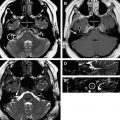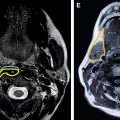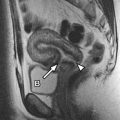Magnetic resonance imaging is the optimal modality for characterizing the ligaments, tendons, muscles, and neurovascular structures of the wrist and hand. Continued refinement in pulse sequence and coil design permits high-resolution examination of the many small structures and complex anatomy of this region. In this context, frequent anatomic variants and common false positives such as normal areas of high signal intensity in ligaments and tendons must be recognized to avoid misdiagnosis and improper treatment. This article discusses the osseous and soft tissue anatomy of the wrist and hand, as well as normal variants.
Magnetic resonance (MR) imaging is the optimal modality for characterizing the ligaments, tendons, muscles, and neurovascular structures of the wrist and hand. Continued refinement in pulse sequence and coil design permits high-resolution examination of the many small structures and complex anatomy of this region. In this context, frequent anatomic variants and common false positives such as normal areas of high signal intensity in ligaments and tendons must be recognized to avoid misdiagnosis and improper treatment. In this article the authors discuss the osseous and soft tissue anatomy of the wrist and hand, as well as normal variants.
Protocols
The hand and wrist are best imaged using a dedicated phased-array coil to obtain high-resolution images while achieving optimal signal-to-noise ratio ( Tables 1 and 2 ). High-field strength 3-Tesla magnets may be used to generate high-quality images, which can enhance evaluation of the ligaments and cartilage as well as the triangular fibrocartilage. Three imaging planes are obtained: axial, coronal, and sagittal. Axial images of the wrist should cover from the distal radius and ulna to the proximal metacarpals with the plane of imaging paralleling the distal radius. The wrist should be in neutral position during imaging. Imaging of the thumb and fingers requires special attention to how the planes of imaging are prescribed. For the thumb, the axial images should be perpendicular to the midshaft of the proximal phalanx. Coronal images can be obtained perpendicular to the line that bisects the sesamoid bones with the sagittal imaging plane perpendicular to the coronal imaging plane. For an individual finger, axial images are obtained along the extent of the digit as prescribed by a best-fit line drawn through its center.
| Pulse Sequence | FOV (cm) | Slice Thickness (mm) | Matrix | TR/TE |
|---|---|---|---|---|
| Axial T1 | 10 | 3 | 320 × 192 | 480–500/19 |
| Axial T2 FS | 10 | 3 | 320 × 192 | >4000/45 |
| Coronal T1 | 10–12 | 3 | 256 × 256 | 575–625/20 |
| Coronal T2 FS | 10–12 | 3 | 320 × 192 | >4500/45–57 |
| Coronal 3D GRE | 10 | 2 | 320 × 224 | 19/10 |
| Sagittal T2 FS | 10 | 3 | 320/192 | >5000/45–49 |
| Pulse Sequence | FOV (cm) | Slice Thickness (mm) | Matrix | TR/TE |
|---|---|---|---|---|
| Axial T1 | 12–16 | 3 | 256 × 192 | 500–750/17–19 |
| Axial T2 FS | 12–16 | 3 | 256 × 192 | >3500/55–70 |
| Coronal T1 | 20 | 3 | 256 × 256 | 400–675/15–18 |
| Coronal T2 FS | 20 | 3 | 256 × 192 | >3500/55 |
| Coronal 2D GRE | 20 | 2 | 320 × 240 | 180/9 |
| Sagittal T2 FS | 20 | 3 | 256 × 192 | >5000/55 |
Osseous structures
Whereas the ulna forms the dominant articulation at the elbow, the radius is the larger bone at the wrist and provides the largest articular surface. On axial images, the distal radius forms a broad rectangle. The adjacent radial head has the shape of a circle in cross section and articulates with a slight concavity in the medial border of the radius, the sigmoid notch. On coronal images, the margins of the radial metaphysis, physis, and epiphysis are well demonstrated. The radial epiphysis is larger at the lateral aspect, where it terminates at the radial styloid process, and as a result it has a roughly triangular shape when viewed in the coronal plane. The slightly concave distal articular surface is angled medially and in the volar direction with respect to the radial shaft. Two shallow depressions along this surface articulate with the scaphoid and lunate bones. As seen on coronal images, the distal ulna is separated from the carpal bones by the triangular fibrocartilage. The central portion of the ulnar epiphysis forms the ulnar head, a rounded disk that articulates with the triangular fibrocartilage and the medial radius. The styloid process projects from the posteromedial aspect of the distal ulna and is separated from the ulnar head by a narrow groove.
The eight carpal bones are organized into proximal and distal rows that are well demonstrated on coronal MR images ( Fig. 1 ). From lateral to medial, the proximal carpal row consists of the scaphoid, lunate, triquetrum, and pisiform bones. The trapezium, trapezoid, capitate, and hamate bones constitute the distal carpal row. In the normal wrist, a continuous line termed the proximal arc can be drawn along the base of the scaphoid, lunate, and triquetrum, separating the proximal carpal row from the radius and ulna. Similarly, a distal arc can be drawn separating the rounded base of the capitate and the adjacent somewhat triangular-shaped hamate from the cradle formed by the scaphoid, lunate, and triquetrum. The hook of the hamate, also known as the hamulus, is a hook-like process extending from the volar surface of the hamate that is best seen on axial images ( Fig. 2 ). Sagittal images best reveal the normal alignment of the central column of the wrist in neutral position ( Fig. 3 ). The base of the capitate sits within the crescent-shaped lunate, which itself is perpendicular to the longitudinal axis of the radius. A line drawn along the axis of the radial shaft bisects the lunate, the capitate, and the third metacarpal.
The osseous structures of the hand consist of the metacarpals and proximal, middle, and distal phalanges. The metacarpals and phalanges can be divided into a proximal base, middle shaft, and distal head. The articulations between these long bones include the metacarpophalangeal (MCP), proximal interphalangeal (PIP), and distal interphalangeal (DIP) joints. The thumb lacks a middle phalanx.
In addition to the long bones of the hand, additional sesamoid bones can be found at the palmar aspects of the MCP joints. Like other sesamoid bones, these are embedded within tendons and provide a mechanical advantage to the tendons by displacing them slightly from their joints. Most individuals have five sesamoids in the hand: at the MCP joints of the first, second, and fifth digits, as well as at the interphalangeal joint of the thumb. In the thumb, the two more proximal sesamoids are ensheathed by the adductor pollicis and the flexor pollicis brevis tendons. The number and location of the sesamoids of the hand can vary between individuals.
Osseous structures
Whereas the ulna forms the dominant articulation at the elbow, the radius is the larger bone at the wrist and provides the largest articular surface. On axial images, the distal radius forms a broad rectangle. The adjacent radial head has the shape of a circle in cross section and articulates with a slight concavity in the medial border of the radius, the sigmoid notch. On coronal images, the margins of the radial metaphysis, physis, and epiphysis are well demonstrated. The radial epiphysis is larger at the lateral aspect, where it terminates at the radial styloid process, and as a result it has a roughly triangular shape when viewed in the coronal plane. The slightly concave distal articular surface is angled medially and in the volar direction with respect to the radial shaft. Two shallow depressions along this surface articulate with the scaphoid and lunate bones. As seen on coronal images, the distal ulna is separated from the carpal bones by the triangular fibrocartilage. The central portion of the ulnar epiphysis forms the ulnar head, a rounded disk that articulates with the triangular fibrocartilage and the medial radius. The styloid process projects from the posteromedial aspect of the distal ulna and is separated from the ulnar head by a narrow groove.
The eight carpal bones are organized into proximal and distal rows that are well demonstrated on coronal MR images ( Fig. 1 ). From lateral to medial, the proximal carpal row consists of the scaphoid, lunate, triquetrum, and pisiform bones. The trapezium, trapezoid, capitate, and hamate bones constitute the distal carpal row. In the normal wrist, a continuous line termed the proximal arc can be drawn along the base of the scaphoid, lunate, and triquetrum, separating the proximal carpal row from the radius and ulna. Similarly, a distal arc can be drawn separating the rounded base of the capitate and the adjacent somewhat triangular-shaped hamate from the cradle formed by the scaphoid, lunate, and triquetrum. The hook of the hamate, also known as the hamulus, is a hook-like process extending from the volar surface of the hamate that is best seen on axial images ( Fig. 2 ). Sagittal images best reveal the normal alignment of the central column of the wrist in neutral position ( Fig. 3 ). The base of the capitate sits within the crescent-shaped lunate, which itself is perpendicular to the longitudinal axis of the radius. A line drawn along the axis of the radial shaft bisects the lunate, the capitate, and the third metacarpal.
The osseous structures of the hand consist of the metacarpals and proximal, middle, and distal phalanges. The metacarpals and phalanges can be divided into a proximal base, middle shaft, and distal head. The articulations between these long bones include the metacarpophalangeal (MCP), proximal interphalangeal (PIP), and distal interphalangeal (DIP) joints. The thumb lacks a middle phalanx.
In addition to the long bones of the hand, additional sesamoid bones can be found at the palmar aspects of the MCP joints. Like other sesamoid bones, these are embedded within tendons and provide a mechanical advantage to the tendons by displacing them slightly from their joints. Most individuals have five sesamoids in the hand: at the MCP joints of the first, second, and fifth digits, as well as at the interphalangeal joint of the thumb. In the thumb, the two more proximal sesamoids are ensheathed by the adductor pollicis and the flexor pollicis brevis tendons. The number and location of the sesamoids of the hand can vary between individuals.
Ligaments and cartilaginous structures
Wrist
The intrinsic ligaments of the wrist connect adjacent carpal bones to each other, limiting their motion and providing stability to the base of the hand. From the standpoint of stability, the most important of the intercarpal ligaments are the scapholunate and lunotriquetral ligaments ( Fig. 4 ). These ligaments travel along the proximal arc, separating the radiocarpal compartment from the midcarpal compartment, and are best seen on coronal, thin-section gradient images. The scapholunate ligament connects the proximal margin of the scaphoid to that of the lunate. The lunotriquetral ligament connects the proximal aspect of the lunate to the base of the triquetrum. These ligaments are thicker at their volar and dorsal aspects and are membranous in the middle. The dorsal portion of the scapholunate ligament is thicker than the volar portion and is most important for stability. In contrast, the volar component of the lunotriquetral ligament is thicker and stronger than the corresponding dorsal component.
The extrinsic ligaments connect the distal radius and ulna to the carpal bones, and can be divided into volar and dorsal ligaments. The course of the ligaments can be appreciated on thin-section coronal gradient echo images. The extrinsic ligaments run obliquely, and are seen in cross section between the carpal bones and overlying flexor and extensor tendons on sagittal images. The volar (or palmar) extrinsic ligaments are generally thicker and stronger than the dorsal ligaments, and include the short and long radiolunate, the radioscaphocapitate, the radiolunotriquetral, the ulnotriquetral, and the ulnolunate ligaments ( Fig. 5 A). The most important of these are the radioscaphocapitate and radiolunotriquetral ligaments (see Fig. 5 B). The radioscaphocapitate ligament arises on the volar surface of the radial styloid process, courses over the waist of the scaphoid, and attaches to the capitate. The radiolunotriquetral ligament originates medial to the radioscaphocapitate, invests both the lunate and triquetrum, and is the largest ligament of the wrist. The dorsal extrinsic ligaments include the dorsal radioscaphoid, radiolunate, and radiotriquetral ligaments, in addition to other minor ligaments ( Fig. 6 ).








